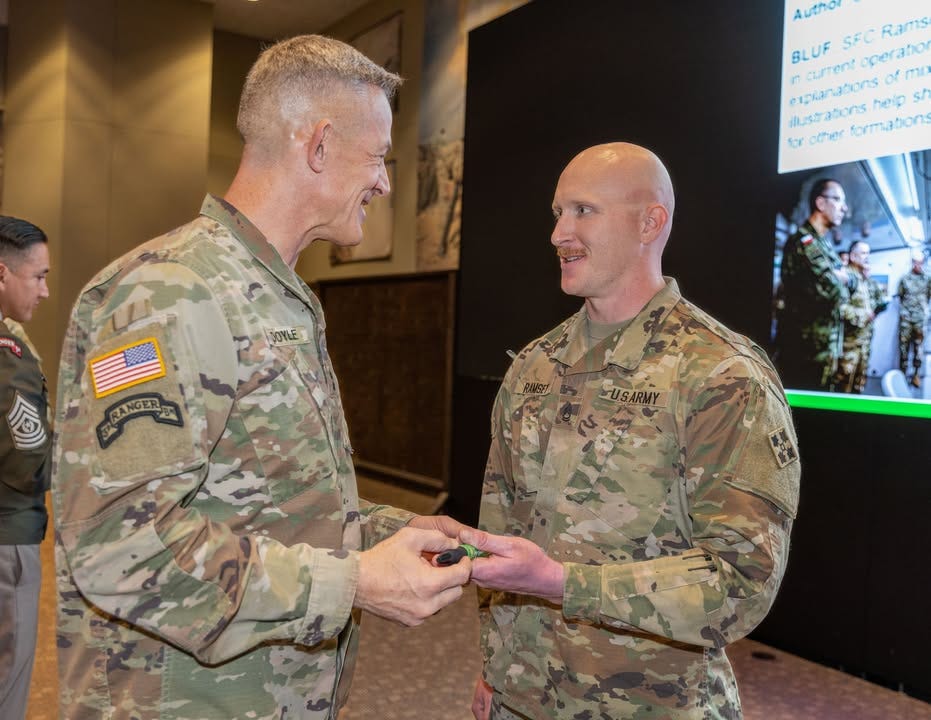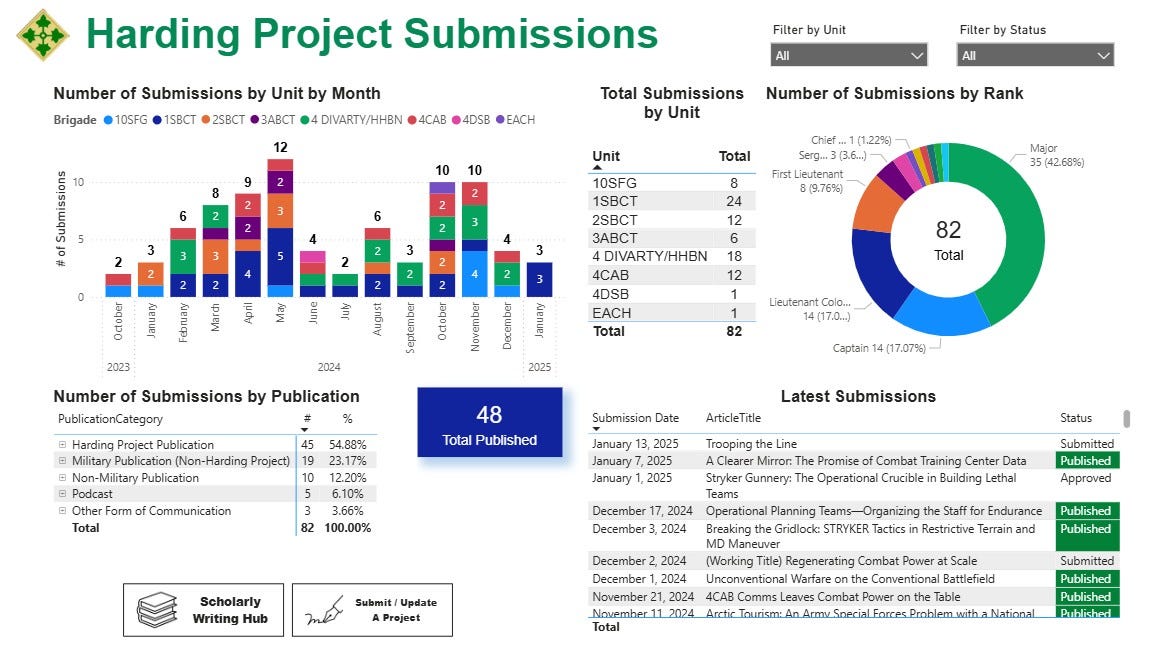A Writing Resolution for 2025
Up-Gun Your Program with Division-Level Focus
For our Harding Project community, consider adding a resolution to your list: up-gun your writing program with division-level focus—and the resources that follow.
Employ the most potent assets in your organization’s arsenal in 2025. We have seen these powerful tools transform a culture over the past year within the 4th Infantry Division and across Fort Carson.
Over the past nine months, Fort Carson-based authors published 40 articles through a variety of forums. These outlets included Army branch journals, military-adjacent publications, civilian professional magazines, and podcasts. Many more works will hit these publications in the year ahead.
4th Infantry Division’s Commanding General presents the “Green Pen Award” to Sgt. First Class Christian Ramsey for outstanding writing in December 2024. His November 2024 Military Review article was subsequently included in both the Chief of Staff of the Army’s and Sergeant Major of the Army’s Recommended Articles for January 2025. (Photo by 4th Infantry Division Public Affairs)
Four elements of the Ivy Division's effort can assist in leveling-up your writing program:
Reward – Recognition by leaders helps align incentives to write.
Amplify – Judicious use of the organization’s media expertise can extend an article’s reach.
Connect – Key leaders and low-density expertise resident in a headquarters can support an author’s project.
Track – Understanding the impact of your efforts, whether quantitatively or qualitatively, contributes to a virtuous cycle.
These four actions complement the sage advice of a former writing coach. He shared two secrets to becoming a productive writer: an editor and a deadline.
The Harding Project has helped with the first, recruiting a talented cohort of editors across Army branch journals. They have even collected and shared valuable insights from authors and editors across the Army in the Project's special edition of Military Review, including best practices for unit-level writing programs. But commands, specifically divisions, can help with the latter. They provide the emphasis to encourage would-be authors to cross the finish line and publish their thoughts, advancing our profession in the process.
Reward: Power of the Green Pen
Rewards, even simple ones, can motivate. Our Commanding General awards a green pen monthly to outstanding writers across Fort Carson. Not just a green pen, the “Green Pen Award.”
The Army’s Command and General Staff College has a longstanding tradition of awarding its “pen awards” in gold, silver, and bronze. The 4th Infantry Division's award is green in honor of our patch’s well-known green ivy leaves.
We can envision other similar awards across our Army. An orange pen for our Army's signal corps units. A red pen for engineer units. Creativity is the only limitation.
The recognition rewards good writing, like topical articles, and writers of interest, like junior authors or non-commissioned officers. The presentation also offers an event to publicize—occasionally on division-level social media properties. This practice can energize contributions to key efforts, like the “Muddy Boots” section of the NCO Journal, to encourage writing among our non-commissioned officer corps. And it reinforces the personal gratification and professional growth that come from publishing, particularly for those new to the practice. Most importantly, it demonstrates the command values professional writing and supports a culture of writing.
Amplify: Megaphone for Writers
Division resources can help champion the importance of professional writing. When appropriate, they can also amplify the reach of an author’s work after it is published online or in a branch journal. Public affairs professionals embedded in a division headquarters can use two particular communication channels to highlight the author’s work: social media and earned media.
While all the disclaimers on endorsing specific articles remain, the public affairs team can encourage the process of writing itself by highlighting success. The Army’s senior leaders have routinely recognized articles and authors alike. Divisions can do the same. And the simplest way they can do so is by using their unit social media platforms, reaching far broader audiences than any single author or Army branch publication typically can. A recent Harding Project Substack contributor provided some constructive guidance about how to implement a social media strategy for articles.
The other way to extend reach—one where we have experienced success for our Ivy Division authors—is using the article’s summary as a pitch to a journalist who covers that subject matter. If a reporter agrees to write an article on the topic, then the reach of the author’s writing extends even further based upon the outlet’s readership. A good example is how we pitched an article with a compelling concept, like “Moneyball for Gunnery,” to a military journalist who highlighted it on their platform. This truly brings the megaphone for writers.
Authors write to influence. Many ideas voiced by authors are important to the profession and should be heard by a broader audience. Division-level expertise and judicious use of tools, like social media and earned media, can help.
Connect: Arrows in the Headquarters Quiver
A division headquarters is chock full of expertise and convening power to support authors. Often this resource is untapped or overlooked. A headquarters boasts the highest density of recent graduates of the Army’s premier professional military education venues. Iron majors. New sergeants major. All primed and ready to contribute as writers.
The division headquarters also houses the highest proportion of low-density expertise. Important specialties—like intelligence, signal, or air defense—are represented en masse in a division headquarters. Other critical enablers and next-gen capabilities, such as cyber and space professionals, are only embedded at the division level. Leaving these experts out of professional dialogue risks sidelining powerful assets to hone ideas. Incorporating them promises taking an idea to the next level.
Division-level focus can mobilize interest and shape the culture of an entire installation. Beyond the division itself, leaders can involve tenant units, harnessing whole-of-installation expertise and contributions. Military hospitals. Security Force Assistance Brigades. Special Forces Groups. All add to the body of professional dialogue. And the Ivy Division leadership has recognized their contributions to great effect.
Lastly, a headquarters can use its convening power to invite speakers and host workshops. In Fall 2024, the Harding Project team visited Fort Carson for a day of highly successful writers’ workshops. These discussions also featured the insights of Harding Fellow editors embedded at branch journals. While such a visit would be impractical for every battalion in the Army, it is possible at the division level.
Track: Identify What You Value
The best organizations measure what matters. Tracking professional writing is possible and valuable.
The Ivy Division has broken new ground in harnessing data to drive decision-making. Quantifying its writing impact is no different. Tracking the number of contributions and correlating those with contributing units offers a measure of performance. Parsing the data for contributions by outlet offers a proxy for impact or effectiveness.
4th Infantry Division’s online dashboard used to track professional writing submissions. (Photo by Andrew Patterson)
Assigning an action officer provides necessary oversight. While not necessarily a “Chief Writing Officer," this individual helps guide the division-wide program, like any other critical planning effort within the division. This individual provides steady energy to drive the command’s vision. They are also a resource to support authors, connecting them with editors and introducing them to writers with similar interests.
A Challenge for the Naysayers
Division-level focus fosters a culture of reflective thought. This effort extends beyond encouraging professional writing. This focus cultivates a culture of experimentation—or as the Ivy Division calls it, a “forward mindset” —and readies our profession for the challenges ahead.
Some may argue that a division is too big to be helpful, or that writing is too personal or too elegant for the blunt force of a division. But this is not the case. Division-wide emphasis can push hobbyists to action. It can move ideas from the brain to the page—and ideally on to print. And that, in turn, can drive other thinkers and authors.
Our challenge to this community: Add these suggestions to your list of writing resolutions. Here’s to writing in 2025!
Major Andrew Patterson is a 4th Infantry Division Planner, the Division's Harding Project Action Officer, and a graduate of the School of Advanced Military Studies.
Lieutenant Colonel Joseph Payton is the 4th Infantry Division's Public Affairs Officer.
Lieutenant Colonel Nicholas Tallant is a Special Forces Officer and the Battalion Commander of the 4th Infantry Division's Headquarters & Headquarters Battalion.







